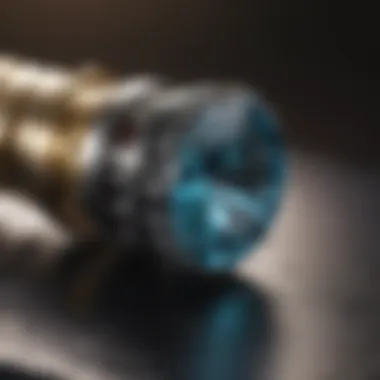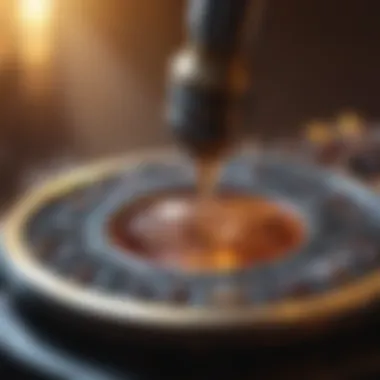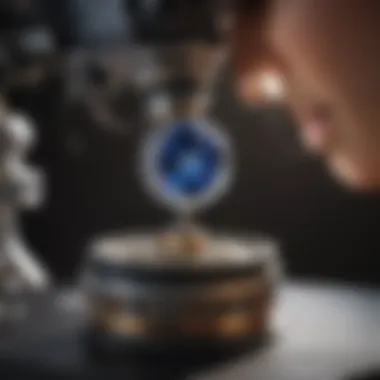Unleashing Creativity and Precision: The Art of Jewelry Making with a Rotary Tool


Overview of Gemstones and Minerals
Gemstones and minerals have played an integral role in human history, dating back to ancient civilizations. The use of gemstones and minerals not only served ornamental purposes but also held significant cultural and societal value. The allure of these precious stones transcends time, resonating with various aspects of human life and identity.
Gemstone Formation and Properties
Understanding gemstone formation is crucial in appreciating their beauty and uniqueness. Gemstones are formed through geological processes that involve intense pressure and heat. These processes result in the creation of crystals with distinct properties such as color, hardness, and luster. These properties define the rarity and value of gemstones, making each piece a treasure to behold.
Types of Gemstones
Gemstones are classified into categories based on their rarity and value. Precious gemstones such as diamonds, rubies, sapphires, and emeralds are highly sought after for their exceptional beauty and rarity. On the other hand, semi-precious gemstones like amethyst, topaz, and turquoise offer a wide range of colors and variations, making them popular choices for jewelry enthusiasts. Additionally, exotic and rare gemstones add a sense of exclusivity and allure to the world of gemstone collection, appealing to connoisseurs seeking unique and distinctive pieces.
Identifying and Evaluating Gemstones
The value of a gemstone is determined by various factors including color, clarity, cut, and carat weight. Gemstone identification requires specialized knowledge and techniques to differentiate between natural and synthetic stones. Professionals use tools like loupes and refractometers to assess gemstone quality and authenticity accurately. Evaluating gemstones involves a meticulous process of inspection and testing to ensure their purity and desirability.
Caring for Gemstones
Proper care and maintenance are essential to preserve the beauty and longevity of gemstones. Cleaning gemstones with mild soap and water helps remove dirt and debris that can dull their appearance. Storing gemstones separately from other jewelry pieces prevents scratches and damage. Avoiding common mistakes such as using harsh chemicals or exposing gemstones to extreme temperatures is crucial in maintaining their brilliance. Specific gem types may require specialized care instructions to prevent damage and ensure enduring beauty.
Introduction
Jewelry craftsmanship and maintenance have reached new heights with the integration of rotary tools. This section serves as an essential gateway to understanding the profound impact of these tools on the art of jewelry making. Dive into the intricate world of precision and creativity as we explore the intricate details, unique benefits, and considerations that come with utilizing rotary tools in the crafting and maintenance of exquisite jewelry pieces.
Unveiling the Artistry
The Role of Precision in Jewelry Making
Precision plays a pivotal role in elevating the craftsmanship of jewelry making to unmatched levels of excellence. The meticulous attention to detail, accuracy, and fine-tuned movements are the foundational elements that define the essence of precision in this art form. By delving into the specifics of precision, jewelry artisans are able to achieve unparalleled levels of intricacy and sophistication in their creations. The integration of precise tools like rotary tools enhances the scope of possibilities, allowing for the realization of intricate designs that were once thought to be unattainable. Despite the challenges that precision entails, the rewards are boundless, offering jewelry designers the opportunity to push the boundaries of their creativity and skill.
The Evolution of Tools in Craftsmanship


The evolution of tools in the realm of jewelry craftsmanship has been a continuous journey towards refinement and innovation. With each technological advancement, artisans have been able to widen their horizons and explore new realms of creativity. The adaptability and flexibility of modern tools have revolutionized the way jewelry is created, bridging the gap between traditional techniques and contemporary demands. The integration of cutting-edge tools like rotary tools has ushered in a new era of craftsmanship, blending age-old techniques with modern efficiency. Despite some challenges that come with adopting new tools, the benefits far outweigh the drawbacks, positioning artisans at the forefront of innovation and ingenuity.
The Essence of a Rotary Tool
Introduction to Rotary Tools
Introducing a rotary tool into the realm of jewelry making brings forth a myriad of possibilities and advantages. These versatile tools offer precision, control, and agility, enabling artisans to execute intricate designs with finesse. The compact nature of rotary tools makes them ideal for working on delicate jewelry pieces, ensuring a steady hand and impeccable results. By acquainting oneself with the intricacies of rotary tools, artisans can unlock a world of potential that propels their craft to new heights of sophistication.
Benefits of Using Rotary Tools in Jewelry Work
The advantages of incorporating rotary tools into jewelry work are manifold and significant. From enhancing efficiency and accuracy to enabling intricate detailing and personalization, these tools are a cornerstone of modern jewelry craftsmanship. The ability to precisely carve, engrave, and polish with ease empowers artisans to bring their artistic visions to life with precision and finesse. While some may find the learning curve challenging, the rewards of mastering rotary tools in jewelry work are unparalleled, offering a gateway to unparalleled creativity and flawless execution.
Crafting with Precision
Crafting with precision is a cornerstone of jewelry making, requiring meticulous attention to detail and exactitude in execution. In the realm of jewelry craftsmanship, precision ensures that every intricate design and delicate carving is flawlessly executed. Maintaining precision is crucial for achieving impeccable results in gemstone setting, polishing, and maintenance. Utilizing a rotary tool enhances the precision of intricate tasks, allowing artisans to create stunning pieces with utmost accuracy and finesse. The benefits of precise craftsmanship extend beyond aesthetics, influencing the durability and quality of the final jewelry pieces.
Detailing and Carving
Creating Intricate Designs
Creating intricate designs is an art form that demands a keen eye for detail and a steady hand. The process of detailing involves crafting elaborate patterns and motifs on metal surfaces, gemstones, or jewelry settings. Artisans employ specialized tools, including rotary tools, to bring their intricate designs to life with precision and clarity. The intricate designs add depth and sophistication to jewelry pieces, showcasing the artisan's skill and creativity.
Precision Carving Techniques
Precision carving techniques are essential for sculpting and shaping jewelry components with accuracy and finesse. Carving intricate details on gemstones or metal requires steady hands and controlled movements. Artisans utilize rotary tools equipped with various carving attachments to achieve precise cuts and intricate detailing. These techniques enable artisans to create customized designs and exquisite textures, enhancing the overall aesthetics of the jewelry piece. Adherence to precise carving techniques is paramount in elevating the quality and visual allure of the final jewelry creation.
Engraving and Etching
Personalization Through Engraving
Personalization through engraving adds a unique touch of individuality to jewelry pieces, making them truly personalized and meaningful. Engraving allows artisans to inscribe names, dates, or special messages onto jewelry items, creating cherished keepsakes for customers. The precision of engraving achieved through rotary tools ensures clear and precise markings, enhancing the overall sentiment and value of the jewelry piece.
Etching for Unique Patterns


Etching for unique patterns is a technique that involves creating intricate designs on jewelry surfaces through acid etching. This process results in intricate patterns and textures that add depth and character to jewelry pieces. Artisans utilize rotary tools with specialized etching attachments to carefully etch designs onto metal surfaces. The versatility of etching techniques offers artisans the flexibility to experiment with various patterns and styles, pushing the boundaries of conventional jewelry design and sparking creativity throughout the crafting process.
Enhancing Gemstones
Gemstones play a pivotal role in the realm of jewelry, captivating enthusiasts and collectors with their mesmerizing allure. The craft of enhancing gemstones goes beyond mere aesthetics; it is a meticulous process that elevates the beauty and allure of each stone to its full potential. In the context of this article, exploring the techniques involved in enhancing gemstones offers insights into the intricate world of jewelry craftsmanship. From revealing the inner radiance of a gemstone to refining its surface to perfection, the process of enhancing gemstones is fundamental to creating exquisite pieces of jewelry. Through utilizing a rotary tool in this endeavor, artisans can achieve precision and finesse in enhancing gemstones, ensuring each piece stands out with unparalleled brilliance and charm.
Polishing and Finishing
Bringing Out the Sparkle
The essence of any well-crafted piece of jewelry lies in its ability to radiate brilliance and captivate the beholder. When it comes to bringing out the sparkle in gemstones, the meticulous art of polishing plays a pivotal role. By skillfully refining the surface of gemstones, artisans can unlock their innate luster and vibrancy, creating a dazzling display of light and color. The process of bringing out the sparkle involves delicately smoothing the surface of each gemstone, removing imperfections, and enhancing its reflective properties. This aspect of jewelry making contributes significantly to the overall appeal of a piece, amplifying its visual impact and allure.
Techniques for Flawless Finish
Achieving a flawless finish in jewelry design is synonymous with perfection and attention to detail. Techniques for flawless finishing encompass a range of methods aimed at refining the surface of gemstones to impeccable smoothness and shine. From using precise buffing motions to applying specialized polishing compounds, artisans can ensure that each gemstone emerges with a mirror-like finish. The key characteristic of these techniques lies in their ability to elevate the aesthetic quality of gemstones, highlighting their inherent beauty and brilliance. While these methods enhance the overall appeal of jewelry pieces, they also contribute to the durability and longevity of the gemstones, ensuring they withstand the test of time with grace and elegance.
Setting and Repairing
Setting Gemstones Securely
The art of setting gemstones securely is crucial in jewelry making, as it not only enhances the visual appeal of a piece but also ensures the gemstones remain firmly in place. By exploring the intricate process of setting gemstones, artisans can discover the nuances of achieving both aesthetic beauty and structural integrity in their creations. The key characteristic of securely setting gemstones lies in the precision and expertise required to position each stone perfectly within its setting, creating a harmonious and secure attachment. This aspect is not only beneficial in enhancing the overall design of jewelry pieces but also provides reassurance to wearers that their precious gemstones are protected and showcased elegantly.
Repairing Chips and Scratches
Despite the durability of gemstones, chips and scratches may occur over time due to wear and tear. In such instances, the art of repairing chips and scratches becomes essential in maintaining the pristine condition of jewelry pieces. By delving into the techniques of repairing minor imperfections, artisans can restore the former glory of gemstones and prolong their lifespan. The unique feature of repairing chips and scratches lies in its ability to salvage damaged gemstones, preserving their beauty and value. While these techniques offer practical solutions to common issues faced in jewelry maintenance, they also highlight the resilience and versatility of gemstones in withstanding the test of time.
Maintenance and Care
Maintenance and Care play a pivotal role in the realm of jewelry making, ensuring the longevity and beauty of exquisite pieces. In this section, we will delve into the intricate processes that uphold the luster and integrity of finely crafted jewelry. Through meticulous attention to detail, artisans and collectors alike can preserve the splendor of gemstones and metalwork. With a focus on precision and expertise, Maintenance and Care elevate the artistry of jewelry to new heights. By embracing proper techniques and considerations, jewelers can protect their creations for generations to come. Whether it's cleaning a cherished piece or addressing common issues, the significance of Maintenance and Care cannot be overstated in the world of jewelry crafting.
Cleaning and Preservation


Proper Cleaning Techniques
Proper Cleaning Techniques are the cornerstone of preserving the allure and brilliance of jewelry. The meticulous application of suitable cleaning agents and methods ensures that each piece maintains its original gleam and charm. By adopting Proper Cleaning Techniques, artisans can safeguard the delicate surfaces of gemstones and metals, preventing tarnishing and dullness. The gentle yet effective nature of these techniques makes them an indispensable choice for maintaining jewelry's pristine condition. Their unique feature lies in the ability to remove impurities without causing any harm to the precious materials, making them ideal for preserving the elegance of jewelry creations.
Preserving the Lustre of Jewelry
Preserving the Luster of Jewelry is essential for sustaining the visual appeal and value of valuable pieces. This aspect focuses on protecting the shine and vibrancy of gemstones and metal finishes. By utilizing specialized products and methods, artisans can prevent oxidation and erosion, ensuring that each piece retains its captivating luster. The key characteristic of this preservation method is its ability to fortify the surface of jewelry against environmental factors and wear. While the process may require time and effort, the long-term benefits of preserving jewelry's luster far outweigh any temporary inconvenience.
Troubleshooting and Solutions
Common Issues in Jewelry Maintenance
Understanding Common Issues in Jewelry Maintenance is crucial for addressing challenges that may arise in caring for precious pieces. From tarnishing to loose settings, these issues can hinder the beauty and functionality of jewelry. By identifying and rectifying common maintenance problems promptly, artisans can maintain their creations in optimal condition. The key feature of this troubleshooting approach is its practicality and effectiveness in resolving recurring issues. While these problems may seem daunting at first, having a comprehensive understanding of common jewelry maintenance issues empowers artisans to tackle them with confidence and expertise.
Solutions Using a Rotary Tool
Implementing Solutions Using a Rotary Tool offers a practical and efficient way to address maintenance issues in jewelry making. The versatility of a rotary tool allows artisans to refine and repair intricate details with precision. By harnessing the power of this tool, craftsmen can restore chipped gemstones, repair scratches, and enhance the overall appearance of jewelry. The key characteristic of using a rotary tool for solutions lies in its fine-tuned control and versatility, enabling artisans to achieve meticulous repairs and refinements. While there may be slight limitations to its application, the advantages of using a rotary tool for jewelry maintenance far outweigh any minor drawbacks.
Exploration and Innovation
Pushing Boundaries
Experimentation with New Techniques:
One pivotal aspect of exploring new techniques in jewelry making is the emphasis on continuous improvement and adaptation. Experimentation breeds innovation, enabling artisans to break free from conventional constraints and explore uncharted territories. By embracing unorthodox methods and unconventional materials, artisans can uncover hidden potentials within their craft, leading to the birth of truly unique and revolutionary jewelry pieces.
Pushing the Limits of Creativity:
Pushing the limits of creativity in jewelry making involves daring to challenge conventional norms and redefine traditional aesthetics. By infusing elements of surprise and novelty into their designs, artisans can captivate audiences with unexpected beauty and elegance. This approach not only sets them apart in a saturated market but also propels the art of jewelry making into uncharted waters, paving the way for new trends and design philosophies.
Future Prospects
Incorporating Technology in Jewelry Making:
The integration of technology into jewelry making heralds a new frontier of possibilities, unlocking realms of creativity previously inaccessible. By harnessing the power of cutting-edge tools and software, artisans can streamline their design process, enhance precision, and experiment with avant-garde concepts. This symbiosis between tradition and technology breeds a new generation of jewelry makers who are at the forefront of innovation and design excellence.
Revolutionizing the Craft with Innovation:
Revolutionizing the craft of jewelry making through innovation involves reimagining time-honored techniques and infusing them with a modern twist. By embracing change and adaptation, artisans can breathe new life into age-old traditions, creating pieces that resonate with contemporary sensibilities. This evolutionary approach not only preserves the heritage of jewelry making but also propels it into a realm of perpetual innovation and reinvention.







